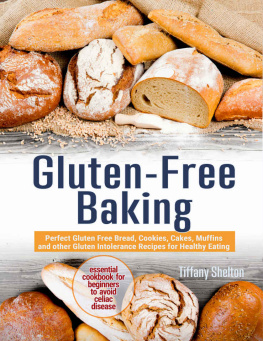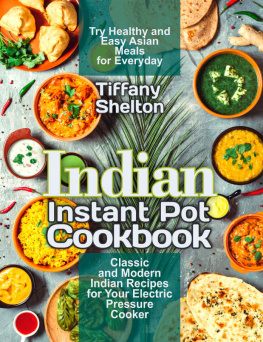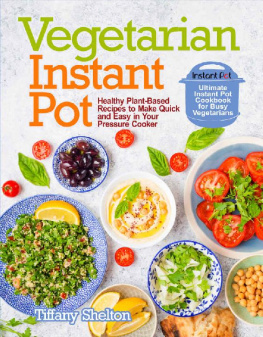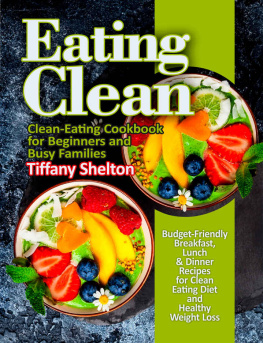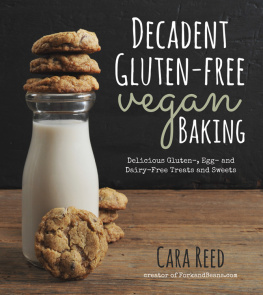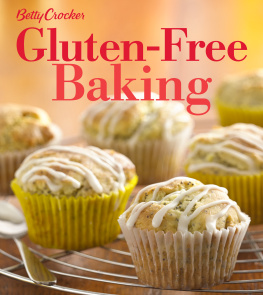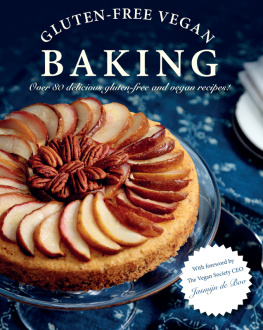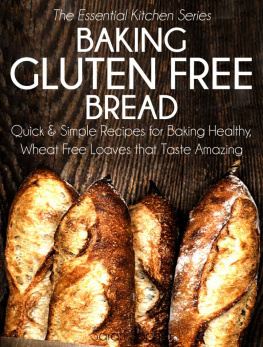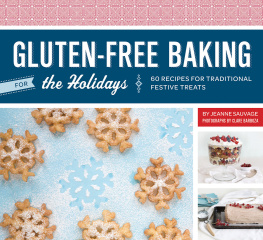Gluten-Free Baking
Perfect Gluten Free Bread, Cookies, Cakes, Muffins and other Gluten Intolerance Recipes for Healthy Eating on a Gluten-Free Diet
The Essential Cookbook for Beginners
to Avoid Celiac Disease
Tiffany Shelton
Copyright 2019 by Tiffany Shelton.
All rights reserved.
No part of this book may be reproduced in any form or by any electronic or mechanical means, except in the case of a brief quotation embodied in articles or reviews, without written permission from its publisher.
Disclaimer
The recipes and information in this book are provided for educational purposes only. Please always consult a licensed professional before making changes to your lifestyle or diet. The author and publisher shall have neither liability nor responsibility to anyone with respect to any loss or damage caused or alleged to be caused directly or indirectly by the information contained in this book. All trademarks and brands within this book are for clarifying purposes only and are owned by the owners themselves, not affiliated with this document.
Images from shutterstock.com

CONTENTS

INTRODUCTION
A ccording to the National Institute of Health in the US, around 1 in every 133 Americans may be affected by celiac disease, but 97 percent of sufferers will go undiagnosed. Its also estimated that between 5 and 10 percent of the worlds population may be suffering some form of gluten sensitivity. A growing number of doctors believe gluten consumption is directly responsible for many common intestinal and nonintestinal complaints, and symptoms can be improved greatly or completely cured by removing gluten from the diet.
Living gluten-free doesnt mean you have to sacrifice your favorite baked goods. In fact, each of the more than 55 easy-to-make recipes found in this book is the result of passion to take the everyday comfort foods we each hold dear and reinvent them so that theyre not only acceptable gluten-free substitutes for old favorites, but are so delightfully flavorful that you wont even notice anything is missing.
Baking is an art as well as a science. My heartfelt mission in writing this book is to provide you with a whole host of deliciously comforting gluten-free baking recipes, while also inspiring you to rediscover the joy of sharing your delightful creations with those you love. With the easy, delicious recipes found in this book, your kitchen can once again become a welcome gathering place for you, your family, and friends to break bread and share your lives with one another.
CHAPTER 1. The Basics
What is Gluten?
Gluten is an elastic substance found in grains such as wheat, barley and rye. It is nearly everywhere, most especially in processed food items. It is found in almost every product from cereal to salad dressings.
You can see below on how gluten can end up on foodstuffs we purchase:
- Wheat is found in baked products, soups, breads and pasta
- Barley is found in food coloring, malt vinegar, beer
- Rye is found in rye bread, rye beer and cereals
Gluten is a concern because it is associated with several medical conditions. Gluten itself has absolutely no nutritional or health-promoting valueour bodies have no use for it. Sugar, which also faces similar loathing, has some nutritional value as a source of energy. There is no medical information or study concluding that consumption of gluten can promote good health.
Instead, gluten causes disease. Humans have varying degrees of intolerance to gluten, some may feel no symptoms at all while others experience full-blown symptoms of gluten intolerance. Our bodies actually view gluten as a foreign non-food substance. Gluten provokes the immune system to respond pathologically and result to disease. This same thing happens in the condition celiac disease.
Gluten in our food makes us sick and we must do something to get it out of our life. You will find this book very useful in adopting a gluten-free lifestyle.
The most common symptoms of gluten intolerance are:
- Unexplained fatigue
- Gastrointestinal distress (gas, bloating, diarrhea, constipation, vomiting, reflux)
- Headaches (including migraines)
- Mouth sores
- Unintended weight loss/gain
- Inability to concentrate
- Moodiness/depression
- Amenorrhea/delayed menarche (menstrual cycles)
- Bone/joint/muscle pain
- Tingling numbness in the legs
- Thinning of scalp hair
- Anemia
- Chronic abdominal pain
Celiac disease or gluten intolerance worsens symptoms of the following conditions:
- Crohns disease
- Dermatitis herpetiformis (a sister of celiac disease)
- Down syndrome
- Epilepsy
- Gall bladder disease
- Hyperthyroidism/hypothyroidism
- Total IgA deficiency
- Insulin-dependent diabetes (Type 1)
- Infertility
- IBS (Irritable Bowel Syndrome)
- Malnutrition
- Multiple sclerosis
- Non-Hodgkins lymphoma
- Osteoporosis, osteopenia, osteomalacia
- Pancreatic disorders
- Bone fractures
- Peripheral neuropathy
- Primary biliary cirrhosis
- Psoriasis
- Recurrent stomatitis
- Rheumatoid arthritis
- Sclerosing cholangitis
- Sjogren syndrome
- Systemic lupus
- Turner syndrome
- Ulcerative colitis
- Vitiligo
Many people are not aware that they become sicker due to consumption of gluten. Eliminating gluten is an important factor for disease recovery and optimal health.

Managing a Gluten-free Diet
Whilst it is easy to avoid products that obviously contain wheat and glutenbread, cakes, pastathere are a variety of products that contain traces of gluten, some of which are not obvious. It is not always easy to avoid such pitfalls and it is therefore essential to carefully check the ingredients list on product packaging or refer to the manufacturer to ensure that products are gluten-free. At the outset of a gluten-free diet, you want to keep a food diary to record what you eat, as this can help identify problem foods that have made you ill.
All forms of wheat, barley, rye, and spelt must be avoided. This means that regular flours and breads are out, as well as wheat-based products such as beer and pasta. Gluten is also commonly used by food manufacturers in a wide variety of food preparation and can be found in ready-meals and pre-produced food. Wheat used as a thickener in a sauce or products coated in breadcrumbs are also not suitable for people with gluten intolerance.
You need to be extra vigilant at all stages of cooking. It is so easy to take a packet from the kitchen cupboard and add it to a recipe without checking whether the item contains glutenI have found myself doing this on occasion and have just stopped myself in time. I once made stock from chicken bones of a roast chicken, but the chicken had contained a breadcrumb stuffing so there was a good chance that the stock was contaminated with gluten. Luckily, I remembered in time before serving it to my friend who has celiac disease. With time and practice, you will become familiar with which ingredients are safe and which are not. The best advice is just to take a bit of time before you start cooking. Assemble all of your ingredients and check that they are all safe to use before starting to cook.

